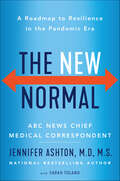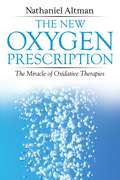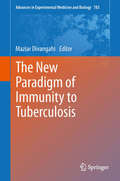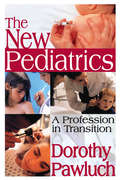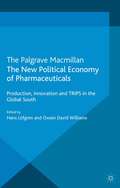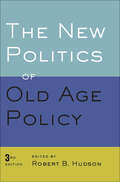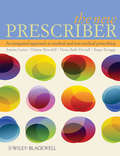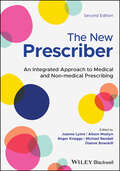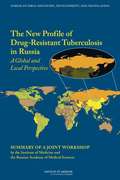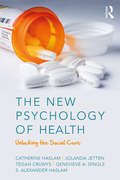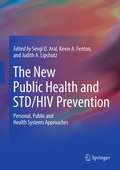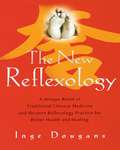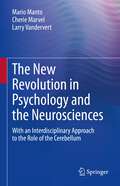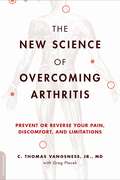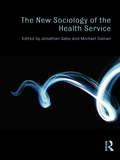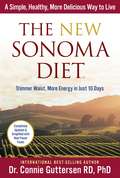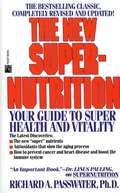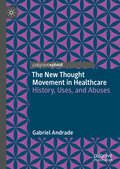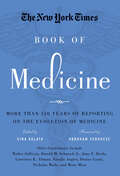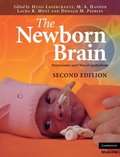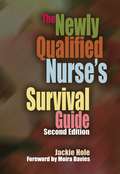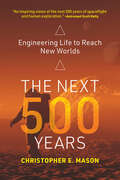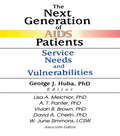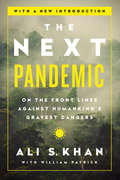- Table View
- List View
The New Normal: A Roadmap to Resilience in the Pandemic Era
by Jennifer Ashton Sarah TolandFrom Dr. Jennifer Ashton—the Chief Medical Correspondent at ABC News covering breaking medical news for Good Morning America and GMA3: What You Need to Know—comes a doctor’s guide to finding resilience in the time of COVID, while staying safe and sane in a rapidly changing world.In March 2020, “normal” life changed, perhaps forever. In its place we were confronted with life and routines that were unusual and different: the new normal. As we’ve all learned since then, the new normal isn’t just about wearing masks and standing six feet apart—it’s about recognizing how to stay safe and sane in a world that is suddenly unfamiliar. And no one understands this evolving landscape better than Dr. Jennifer Ashton. As ABC’s Chief Medical Correspondent, Dr. Ashton has been reporting on the novel coronavirus daily, helping Americans comprehend the urgent medical updates that have shaped the nation’s continued response to this public health crisis. Now in The New Normal, Dr. Ashton offers the essential toolkit for life in this unfamiliar reality. Rooted in her reporting on COVID-19 and the understanding that the virus isn’t going anywhere overnight, The New Normal is built on a simple foundation: thriving in this evolving world demands accepting the new normal for what it is, not what we want it to be. No longer is wellness a buzzword, but an imperative for surviving this unprecedented time. Using her trademark practical, easy-to-follow advice, Dr. Ashton gives you all the necessary information to reclaim control of your life and live safely—from exercise, to diet, to general health—showing how to prepare your body and mind for challenges such as: - Taking proper medical precautions to protect yourself and your loved ones- Exercising during the pandemic, even if you no longer feel safe at the gym- Finding emotional balance through these uncertain times- Deciphering complicated medical news to learn what to trust and what to ignore With these straightforward and accessible strategies and many more, Dr. Ashtonhelps empower you to make the unexpectedly hard decisions about socializing, food-shopping, seeing doctors, and most of all, finding normalcy. At once reassuring and urgent, The New Normal is a holistic roadmap through the ongoing struggles of the pandemic, providing the guidance you need to navigate this unsettling time and take charge of your future wellbeing.
The New Oxygen Prescription: The Miracle of Oxidative Therapies
by Nathaniel AltmanA guide to the latest research in oxygen therapies and their use on the path to optimum health• Presents new clinical advancements and scientific findings from Cuba, Italy, Spain, Russia, China, and the United States • Explores the effectiveness of oxidative therapies for treating many conditions, including heart disease, cancer, HIV, hepatitis, diabetes, MS, macular degeneration, herniated discs, arthritis, Alzheimer’s, Crohn’s, candida, emphysema, and eczema• Includes new research on oxidative therapies in veterinary medicine and dentistry, including its success in treating cavities and preventing infection Scientists now agree that most disease states are caused by oxygen starvation at a cellular level. Polluted air, devitalized foods, and poor breathing habits can all lead to chronic oxygen deficiency, a bodily environment in which toxins thrive as the overall immune response is weakened. Through oxidative therapies--the medical use of ozone (O3) or hydrogen peroxide (H2O2)--we can assist the body in generating the oxygen needed to oxidate viruses and bacteria as well as weak and sick tissue cells, so stronger and healthier cells can take their place.Presenting the latest advancements and clinical findings from Cuba, Italy, Spain, China, Russia, and the United States, as well as recommendations from the International Scientific Committee of Ozone Therapy (ISCO3), Nathaniel Altman explores the effectiveness of oxidative therapies for treating a wide range of conditions, including heart disease, herpes, HIV, diabetes, candida, tonsillitis, macular degeneration, herniated discs, burns, and arthritis. He shows how Cuban and Russian physicians have been successfully treating patients with heart disease with ozone therapy for decades and explains how ozone interacts with cells when introduced into the bloodstream, stimulating the body’s own ability to fight cancer, osteoporosis, and hepatitis. He investigates promising new studies on the use of ozone and hydrogen peroxide therapies to treat Alzheimer’s, Crohn’s, multiple sclerosis, emphysema, eczema, and sepsis and the potential for these therapies to successfully treat new diseases such as Ebola and Zika.The author also explores the expanding use of oxidative therapies in veterinary medicine and dentistry, including their success in treating cavities and preventing infection. Providing a detailed resource section, he explains how to combine oxidative therapies with holistic methods, such as fasting, detox therapies, herbal medicine, and nutritional healing, for a stronger start on the path to optimum health.
The New Paradigm of Immunity to Tuberculosis
by Maziar DivangahiThis book illustrates the intimate relationship between alveolar macrophages and Mycobacterium tuberculosis (M.tb.), and the former's role in both innate and adaptive immunity against M.tb. It covers research done over the last decade. It also explores the role of macrophage death following infection with M.tb. in determining whether successful immunity is stimulated, or whether clinical disease develops; furthermore, the function of host lipid mediators in macrophage death modality are addressed. The book also illustrates how the balance between prostaglandins and lipoxins determines whether infected macrophages undergo apoptosis or necrosis, which is the ultimate factor in the outcome of infection. Finally, it is a synthesis of the authors' recent studies and the studies of others to offer a new understanding of immunity to tuberculosis.
The New Pediatrics: A Profession in Transition
by Dorothy PawluchWhen antibiotics became readily available in the 1950s, the danger of life-threatening infectious childhood diseases virtually disappeared. In that era, pediatricians broadened the core professional task of their specialty--the prevention and treatment of such diseases--to incorporate the behavioral and psychosocial problems of children and adolescents. Pediatricians themselves began to refer to this changing emphasis as the "new pediatrics," and to see the trend as a natural progression of their specialty into new areas of care. At the same time there arose widespread disaffection among practicing general pediatricians, defection to other areas of practice, and a decline in the popularity of pediatrics as a specialty choice.In analyzing the emergence of the new pediatrics as a case study within medical sociology, Pawluch shows how professional concerns and interests infl uence debate around social problems. As sociologists began to take greater interest in the problems of childhood, and as children's lives became increasingly medicalized--as some have argued--it is at least in part because of pediatricians' willingness to endorse medical defi nitions for certain social problems and to provide treatment for them.Pawluch's underlying concern is that medical professionals have begun to make claims for authority in the definition of what constitutes the social problems of childhood. Among the topics she examines are the "dissatisfied pediatrician syndrome," the potential for a crisis in oversupply of pediatricians and competing providers of services, the push for expansion into new areas of care, and possible future developments in this specialty.
The New Political Economy
by Owain David Williams Hans L�fgrenSome two decades will shortly have passed since the WTO's Trade Related Aspects of Intellectual Property Rights agreement came into force in 1995. This volume is the first cross-country analysis of how TRIPS has affected the capacity of 11 major low or medium income countries to produce generic drugs.
The New Politics of Old Age Policy
by Robert B. HudsonA comprehensive overview of current aging policies.As the average age of the U.S. population continues to increase, age-related policies have come under intense scrutiny, sparking heated debates. In the past, older people were seen as a frail, dependent population, but major policies enacted or expanded on their behalf have made them major players in electoral and interest-group politics. This thoroughly revised and updated edition of Robert B. Hudson’s The New Politics of Old Age Policy not only explains the politics behind the country’s age-based programs and describes how those programs work but also assesses how well—or poorly—they meet the growing and changing needs of older Americans. Essays by leading experts in political science, sociology, law, social work, and gerontology address, among other things, theoretical approaches to age-based policy; population dynamics and the impact of growing diversity within the older population; and national, state, and local issues associated with major age-based programs. More than any other source, this book presents the most current information on growing older in the United States, including in-depth analyses of Social Security, Medicare, Medicaid, housing initiatives, the Older Americans Act, the Age Discrimination in Employment Act, and tax policy.Detailed new chapters focus on financial security and retirement in the context of the Great Recession, diversity and inequality in aging populations, and implications of the Affordable Care Act. Scholars, students, and policymakers will appreciate the volume’s timely overview of the evolution of aging policy.
The New Politics of the NHS, Seventh Edition: From Creation To Reinvention
by Rudolf KleinThe New Politics of the NHS has become established over 30 years as the key overview of the NHS, its processes and paths of influence. The seventh edition remains a clear, easy-to-read guide to often complex debates. It encompasses both the background of the evolution of the NHS since its foundation, and a completely up-to-date picture of its prese
The New Prescriber
by Fiona Bath-Hextall Roger Knaggs Joanne Lymn Dianne BowskillThe New Prescriber is a comprehensive, accessible textbook that provides essential coverage of the three core components for prescribing: the client/patient, the evidence, and the pharmacology. Divided into three sections, this text first looks at the consultation with the patient, and outlines legal, professional and ethical frameworks which guide medical and non-medical prescribing. The second section is devoted to evidence-based practice, highlighting key skills essential to all clinicians. This section encourages the student to identify why evidence-based practice should underpin prescribing decisions. The third and final section is concerned with pharmacology. The student is introduced to basic concepts of pharmacodynamics and pharmacokinetics, adverse drug reactions and variability of response. The importance of these pharmacological principles is highlighted throughout the subsequent discussion of drug groups affecting major body systems.Key features:Pulls together all key elements of prescribing using an integrated approach'Stop and Think' boxes and practice application activities provided throughout, enabling the reader to link theory to practiceKey terms and glossary providedThis text is invaluable for all nursing, health and medical students taking courses in prescribing and pharmacology.
The New Prescriber: An Integrated Approach to Medical and Non-medical Prescribing
by Roger Knaggs Joanne Lymn Dianne Bowskill Michael Randall Alison MostynTake an evidence-based approach to prescribing decisions with this comprehensive guide Prescribing decisions are among the most important parts of clinical practice. Balancing patient needs, possible drug interactions, the probability of adverse drug reactions, and more requires an evidence-based approach rooted in pharmacological principles. The New Prescriber: An Integrated Approach to Medical and Non-medical Prescribing offers a thorough, accessible introduction to the core components of prescribing, essential for any student preparing for clinical practice. Now fully updated to reflect the latest best practices and to address questions raised by different prescribing settings, it promises to continue as the key introduction to this vital subject. Readers of the second edition of The New Prescriber will also find: An introduction to the principles of pharmacodynamics and pharmacokineticsNew sections covering topics including illegal and illicit drugs, overdose and deprescribing, and moreA thorough glossary with key terms The New Prescriber is ideal for all non-medical prescribing students, nursing, allied health professionals, and medical students.
The New Profile of Drug-Resistant Tuberculosis in Russia: A Global and Local Perspective
by The National Academy of SciencesAn estimated 2 billion people, one third of the global population, are infected with Mycobacterium tuberculosis, the bacterium that causes tuberculosis. Spread through the air, this infectious disease killed 1. 7 million in 2009, and is the leading killer of people with HIV. Tuberculosis (TB) is also a disease of poverty--the vast majority of tuberculosis deaths occur in the developing world. Exacerbating the devastation caused by TB is the growing threat of drug-resistant forms of the disease in many parts of the world. Drug-resistant tuberculosis presents a number of significant challenges in terms of controlling its spread, diagnosing patients quickly and accurately, and using drugs to treat patients effectively. In Russia in recent decades, the rise of these strains of TB, resistant to standard antibiotic treatment, has been exacerbated by the occurrence of social, political, and economic upheavals. The Institute of Medicine (IOM) Forum on Drug Discovery, Development, and Translation, in conjunction with the Russian Academy of Medical Sciences held a workshop to discuss ways to fight the growing threat of drug-resistant TB. The New Profile of Drug-Resistant Tuberculosis in Russia: A Global and Local Perspective: Summary of a Joint Workshoppresents information from experts on the nature of this threat and how it can be addressed by exploring various treatment and diagnostic options.
The New Psychology of Health: Unlocking the Social Cure
by Jolanda Jetten Alex Haslam Catherine Haslam Tegan Cruwys Genevieve DingleWhy do people who are more socially connected live longer and have better health than those who are socially isolated? Why are social ties at least as good for your health as not smoking, having a good diet, and taking regular exercise? Why is treatment more effective when there is an alliance between therapist and client? Until now, researchers and practitioners have lacked a strong theoretical foundation for answering such questions. This ground-breaking book fills this gap by showing how social identity processes are key to understanding and effectively managing a broad range of health-related problems. Integrating a wealth of evidence that the authors and colleagues around the world have built up over the last decade, The New Psychology of Health provides a powerful framework for reconceptualising the psychological dimensions of a range of conditions – including stress, trauma, ageing, depression, addiction, eating behaviour, brain injury, and pain. Alongside reviews of current approaches to these various issues, each chapter provides an in-depth analysis of the ways in which theory and practice can be enriched by attention to social identity processes. Here the authors show not only how an array of social and structural factors shape health outcomes through their impact on group life, but also how this analysis can be harnessed to promote the delivery of ‘social cures’ in a range of fields. This is a must-have volume for service providers, practitioners, students, and researchers working in a wide range of disciplines and fields, and will also be essential reading for anyone whose goal it is to improve the health and well-being of people and communities in their care.
The New Public Health and STD/HIV Prevention
by Judith A. Lipshutz Kevin A. Fenton Sevgi O. AralDespite effective approaches to prevention, STD and HIV infection rates remain fairly constant. Targeting, implementation, and monitoring of interventions have posed widespread problems, and the recent spate of cuts to prevention budgets has made these roadblocks even more challenging. It is clear that working in sexual health requires both a deeper understanding of STI/HIV epidemiology and an ongoing quest for up-to-date, realistic prevention strategies. The New Public Health and STD/HIV Prevention offers readers leading-edge access to both. Focusing on social determinants of sexual health, at-risk populations, critical factors in approaches to prevention, and reviews of new research, this authoritative volume explores areas as varied as HPV prevention, technology-based interventions, migration as a factor in disease transmission, and competencies key to effective leadership in the field. Dispatches from the frontlines of theory, research, and practice in the U.S. and abroad include: Personal risk, public impact: balancing individual rights and STD/HIV prevention. Distribution of prevention resources and its impact on sexual health. Prevention measures in diverse populations of women. Toward a better approach to preventive interventions with men who have sex with men. Adolescent sexual health and STIs. Reducing disparities in sexual health: lessons from the campaign to eliminate infectious syphilis. Public health professionals of all backgrounds interested in or working in improving sexual health will find The New Public Health and STD/HIV Prevention an indispensable guide to conceptualizing the problems and clarifying possible solutions.
The New Reflexology: A Unique Blend of Traditional Chinese Medicine and Western Reflexology Practice for Better Health and Healing
by Inge DougansReflexology has always been an effective way to relieve stress, alleviate pain, and combat ailments, but in The New Reflexology, internationally acclaimed instructor Inge Dougans shows readers a unique and proven method for getting even better results. Her system - an integration of traditional Chinese medicine (particularly the 5 elements and their 12 meridians), diet, and standard Western reflexology practice - allows practitioners to treat a much wider variety of ailments with greater accuracy and success. In simple and straightforward terms, Dougans explains why the meridians are essential for reflexology, how to use meridian therapy and the 5 elements for effective assessment and treatment, how to relate structural foot problems to imbalances in the rest of the body, and much more. Illustrated with dozens of line drawings that guide readers step-by-step through the treatments, this fresh and highly effective approach is sure to revolutionize the practice of reflexology as we know it.
The New Revolution in Psychology and the Neurosciences: With an Interdisciplinary Approach to the Role of the Cerebellum
by Mario Manto Cherie Marvel Larry VandervertHistorically researchers of neuroscience and psychology have believed that the cerebral cortex produces the unique mental capacities of human beings. However, a prevalence of brain-imaging evidence now shows that the cerebral cortex, while the seat of our everyday experience (notably in working memory), is not predominant in actually formulating our amazing capabilities. Rather, the achievements that mark humans as “Homo sapiens” originate in the cerebellum which increased three- to fourfold in size and acquired massive cognitive and social optimization capabilities over the last million years. Thus, through its optimization of experience and skill of the cerebral cortex, it was the cerebellum that was and is predominant in producing culture, language, mathematics, creativity, and extreme levels of skill in all areas from sports to computer science and art. These optimizing functions of the cerebellum are shown in the cases of Albert Einstein, Wolfgang Amadeus Mozart, Maryam Mirzakhani, and the predictive powers of Stonehenge. This book fills a critical role in bringing courses up-to-date with the profound, basic changes this newly understood predominant role of the cerebellum provides for understanding the mechanisms related to all topics in psychology and neuroscience. It is critical that this “new revolution in psychology and the neurosciences” be introduced and reviewed in courses that are part of both undergraduate and graduate studies in psychology and neuroscience. This text might also be of use to courses in anthropology and cross-disciplinary studies as the cerebellum was critically involved in the evolution of cognitive and social behaviour.
The New Science of Overcoming Arthritis: Prevent or Reverse Your Pain, Discomfort, and Limitations
by Greg Ptacek Thomas VangsnessBattle the growing arthritis epidemic by taking steps now. Arthritis is truly an epidemic: more than 40 million Americans currently have arthritis, it is the leading cause of disability among people age 65 and older, and the overall annual costs to society are figured to be more than $65 billion. While it is present in nearly everyone by age 70, the problem is growing as arthritis more commonly appears in people as young as their 30s. But there is good news-while you can't cure arthritis, you can stave it off or manage it and dramatically improve your life. The New Science of Overcoming Arthritis offers a plan for anyone who wants to prevent or reverse their pain, discomfort, and limitations. It is the first book on arthritis that incorporates the latest research and treatment strategies for a disease that the vast majority of baby boomers will inevitably have to learn to live with. What's more, it provides younger generations with an easy-to-follow game plan for minimizing and even avoiding the more debilitating aspects of arthritis. It answers the most pressing questions, including: Why do we get arthritis? Which arthritis supplements are worthwhile? What are the best arthritis exercise and diet strategies? Which alternative therapies are sensible and safe? What is the latest science about stem cells and future therapies involving our genes and biology? Dr. Vangsness, a seasoned surgeon and team physician for USC Athletics, specializes in sports injuries and is a medical advisor on the cutting edge of arthritis research. He provides practical advice culled from his years working with star collegiate athletes, who are often on the front line in uncovering the best practices for dealing with injuries and the deterioration of the body's joints. While genetics play a large role in determining who will suffer from arthritis, and even how severely, there are strategies for staying active, pain-free, and healthy no matter who you are.
The New Sociology of the Health Service
by Jonathan Gabe Michael CalnanHealth service policy and health policy have changed considerably over the past fifteen years and there is a pressing need for an up-to-date sociological analysis of health policy. Not only have policies themselves changed but new policy themes – such as evidence-based policy and practice, an increasing focus on a primary care led health service, a growing recognition of the need to address inequalities through public health policies and a focus on the views and the voice of the user and the public– have emerged alongside some of the old. Following up the very successful The Sociology of the Health Service, this all-new volume covers a broad range of key contemporary health services issues. It includes chapters on consumerism, technology, evidence-based practice, public health, managerialism and social care among others, and incorporates references to new developments, such as regulation and incentivization, throughout. The New Sociology of the Health Service provides a vital new sociological framework for analyzing health policy and healthcare. It is an important read for all students and researchers of medical sociology and health policy.
The New Sonoma Diet
by Connie GuttersenLose weight, feel better, and enjoy your meals more than you ever thought with this brand new, updated version of the groundbreaking Sonoma plan for easy weight loss and healthy living.
The New Super-Nutrition
by Richard PasswaterFrom the renowned biochemist who created a health revolution with his bestselling Supernutrition in 1975 comes The New Supernutrition. Totally revised and updated, The New Supernutrition focuses on the latest scientific discoveries and offers solutions to the nutrition problems of the nineties. Richard A. Passwater, PhD, is internatinally acclaimed as a leader in research on megavitamins, trace minerals, and other nutrients. In this life-enhancing, health-saving guide, he offers a program of supernutrition talored to your specific needs that can do many things.
The New Thought Movement in Healthcare: History, Uses, and Abuses
by Gabriel AndradeThis book delves into the evolution of the New Thought Movement and its pervasive influence on modern healthcare. The book begins by tracing the roots of the New Thought Movement, originating in the 19th century, emphasizing the power of the mind in healing and personal development. Over time, this philosophy morphed into the contemporary positive thinking industry, becoming a significant component of Western self-help culture. The book explores how these ideas have become a contentious point in today's culture wars, polarized between supporters who credit it for personal empowerment and critics who highlight its limitations and potential harm. Central to the discussion is an in-depth analysis of the New Thought philosophy's impact on the healthcare industry. While acknowledging the potential benefits, such as motivating patients to adopt healthier lifestyles and fostering a sense of personal agency, the book critically examines how this philosophy's emphasis on mental positivity can lead to victim-blaming. It argues that oversimplifying health issues by attributing them solely to personal mindset obscures the multifaceted reality of health, particularly the significant role of social determinants of health and systemic inequities. This critique underscores how attributing illness to insufficient positive thinking can perpetuate stigma and neglect the socio-economic and environmental factors critical for understanding and addressing health challenges. By offering a nuanced perspective, the book aims to catalyze discussions on integrating mindful optimism with a holistic acknowledgment of the complexities inherent in healthcare, striving for a more balanced and equitable approach
The New York Times Book of Medicine: More than 150 Years of Reporting on the Evolution of Medicine
by Gina KolataToday we live longer, healthier lives than ever before in history—a transformation due almost entirely to tremendous advances in medicine. This change is so profound, with many major illnesses nearly wiped out, that its hard now to imagine what the world was like in 1851, when the New York Times began publishing. Treatments for depression, blood pressure, heart disease, ulcers, and diabetes came later; antibiotics were nonexistent, viruses unheard of, and no one realized yet that DNA carried blueprints for life or the importance of stem cells. Edited by award-winning writer Gina Kolata, this eye-opening collection of 150 articles from the New York Times archive charts the developing scientific insights and breakthroughs into diagnosing and treating conditions like typhoid, tuberculosis, cancer, diabetes, Alzheimers, and AIDS, and chronicles the struggles to treat mental illness and the enormous success of vaccines. It also reveals medical mistakes, lapses in ethics, and wrong paths taken in hopes of curing disease. Every illness, every landmark has a tale, and the newspapers top reporters tell each one with perceptiveness and skill.
The Newborn Brain
by Hugo Lagercrantz Laura R. Ment Donald M. Peebles M. A. HansonDevelopment of the brain and the emergence of the mind constitute some of the most important concerns of contemporary biology. Disturbances during fetal life may have profound implications for a child's future neurological and psychological development, which can in turn impact society. The new edition of this highly respected work presents a comprehensive review of the basic mechanisms of brain development and the pathophysiology of disorders of the infant brain, written by a team of distinguished neuroscientists, neonatologists, and neuropediatricians. The book follows the main milestones of brain development, from formation of the neural tube and wiring of the neurons in the brain. Neurotrophic factors, neurotransmitters, glial cell biology, cerebral circulation development of sensory functions are all described in detail. Furthermore, there are more philosophical chapters on the evolution of the brain and the emergence of consciousness. Clinical considerations are highlighted where relevant.
The Newly Qualified Nurse's Survival Guide (Radcliffe Ser.)
by Jackie HoleEven after years of training and hard work, finding yourself on the threshold of your nursing career is often a daunting prospect. In this revised and updated second edition, Jackie Hole provides clear, practical advice on both managing the transition from student to qualified nurse - including getting the most from your final placement and making applications - and practical advice on key areas encountered in the first weeks and months after qualification. Drug safety, dealing with common clinical problems, and how and when to seek expert advice are all covered, while a newly written chapter addresses the key area of infection control. Management aspects such as delegation, objective setting, budgeting, prioritisation of care and time management are outlined clearly and engagingly, along with questions of professional development and career futures. This book will be invaluable to newly-qualified nurses, as well as to student nurses, nurse tutors, and experienced nurses wishing to gain an insight into their own practice and changes in the profession.
The Next 500 Years: Engineering Life to Reach New Worlds
by Christopher E. MasonAn argument that we have a moral duty to colonize other planets and solar systems, and a plan for doing so.Inevitably, life on Earth will come to an end, whether by climate disaster, or by cataclysmic war, or when the sun runs out of fuel in a few billion years. To avoid extinction, will we have to find a new home planet, perhaps even a new solar system, to inhabit? In this provocative and fascinating book, Christopher Mason argues that we have a moral duty to do just that. Because we are the only species aware that life on Earth has an expiration date, we have a responsibility to act as the shepherd of lifeforms--not only for our species but for all species on which we depend and for those still to come (by accidental or designed evolution). Mason argues that the same capacity for ingenuity that has enabled us to build rockets and land on other planets can be applied to redesigning biology so that we can sustainably inhabit those planets. And he lays out a 500-year plan for undertaking the massively ambitious project of reengineering human genetics for life in other worlds.
The Next Generation of AIDS Patients: Service Needs and Vulnerabilities
by George J Huba Vivian BrownGo beyond traditional medical care to treat the whole person!In the past ten years, the treatment and epidemiology of AIDS have changed, and HIV/AIDS services must also change. The Next Generation of AIDS Patients suggests new ways to find and care for persons living with AIDS, not just by offering traditional medical treatment but by delivering needed support services as well. This landmark book defines the startling shift in demographics of this phase of the epidemic. The new AIDS patients have different problems than the white gay men who were strongly affected in the early days of the disease: some are substance abusers or sex workers or their partners, and many have children. Clients who are homeless, poorly educated, not native English speakers, or uninsured have overwhelming social support needs and need extra help to obtain their medical requirements. The Next Generation of AIDS Patients offers detailed analyses to help you determine clients’needs and vulnerability levels, so you can provide complete biopsychosocial services. In addition, the original empirical research in this book reveals which programs deliver the best outcomes for various client populations. The Next Generation of AIDS Patientssupplies you with an effective data modeling approach for determining levels of vulnerability and need, and discusses such vital issues as: identifying and overcoming barriers to HIV care engaging and retaining in care individuals with high levels of unmet need delivering services to diverse minority populations, substance abusers, homeless people, and those who live in rural areas client satisfaction in community service organizationsIn order to develop successful community-based health care and support services, medical and social work professionals must take the new face of this disease into account. The Next Generation of AIDS Patients offers practical advice, readily applicable theory, and proven strategies for caring for people living with AIDS.
The Next Pandemic: On the Front Lines Against Humankind's Gravest Dangers
by William Patrick Ali KhanDuring the 2014 Ebola crisis, the public watched with rapt attention as a handful of Americans contracted the deadly fever and were transported to treatment facilities in the United States. We charted the movements of Dr. Craig Spencer, whose three-mile jog and subway ride to a bowling alley became national news, fearing for our lives. Yet the panic far outstripped the reality of the situation; Dr. Spencer survived, and the disease spread no further. The American Ebola outbreak began and ended with two fatalities.To Dr. Ali Khan, the 2014 Ebola scare was simply another example of public paranoia about infectious disease; he has been on the front lines of each one - and many we didn't hear about- over the last 25 years. During the 1995 Ebola outbreak in Zaire, Khan found patient zero; he traveled to Washington, DC, in 2001 as a first responder in the anthrax crisis; and went to southeast Asia to treat patients of SARS. The University of Nebraska Medical Center, where Khan is now Dean of Public Health, is one of four biohazard containment units in the United States; four Ebola patients were treated there in 2014.In this riveting book, Khan tells the dramatic stories of these crises-as well as the stories we don't know-of congo-crimean hemorrhagic fever infecting abattoirs in the United Arab Emirates, as cigarette-smoking local doctors rushed to the scene, for instance; or of being shot at by militias in the African bush while trying to treat monkeypox.The book's message is every bit as urgent as his stories: we are focused on the wrong problems. Khan reminds us that the danger of an outbreak-more real than ever in the age of climate change and global travel-is not a matter of which disease is the most deadly or violent. Instead, he urges readers to spread good information and practice essential habits.Untitled CDC Memoir is a vivid and necessary book about rampant and violent diseases, and disasters narrowly averted- and the tools we need to keep them at bay.
